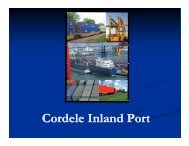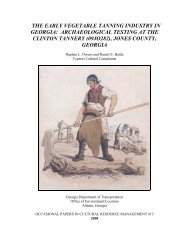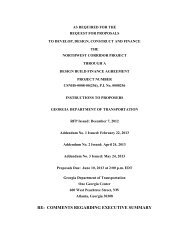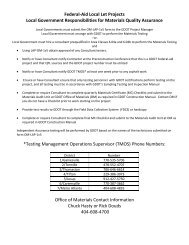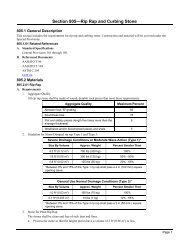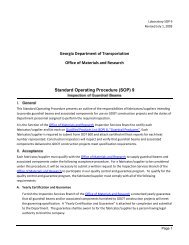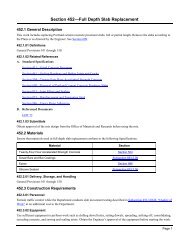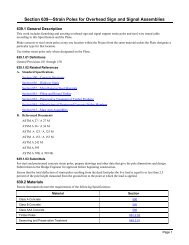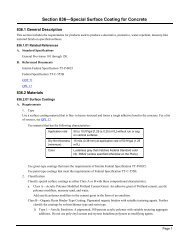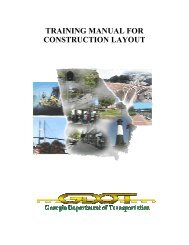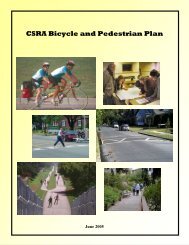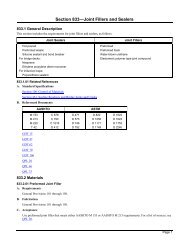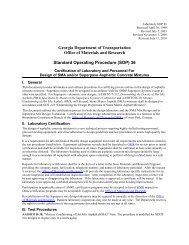Section 859âGuard Rail Components
Section 859âGuard Rail Components
Section 859âGuard Rail Components
You also want an ePaper? Increase the reach of your titles
YUMPU automatically turns print PDFs into web optimized ePapers that Google loves.
<strong>Section</strong> 859—Guard <strong>Rail</strong><br />
859.1 General Description<br />
This section includes the requirements for guard rail components, such as:<br />
Guard rail elements, terminal sections, and fittings<br />
Cable end anchor assemblies<br />
Steel guard rail posts and offset blocks<br />
Wood guard rail posts and offset blocks<br />
859.1.01 Related References<br />
A. Standard Specifications<br />
<strong>Section</strong> 106—Control of Materials<br />
<strong>Section</strong> 863—Preservative Treatment of Timber Products<br />
B. Referenced Documents<br />
ASTM<br />
AASHTO<br />
A 123/ A 123M<br />
A 153/ A 153 M<br />
A 449<br />
A 575<br />
A 576<br />
A 709/A 709M<br />
A 741<br />
A 769/A 769M<br />
B 209 (B 209M)<br />
B 211 (B 211M)<br />
F 568<br />
M 180<br />
1994 SPIB rules, paragraph 402<br />
QPL 8<br />
859.2 Materials<br />
859.2.01 Guard <strong>Rail</strong> Elements, Terminal <strong>Section</strong>s, and Fittings<br />
A. Requirements<br />
1. Steel Guard rail<br />
Use guard rail parts that meet AASHTO M 180 requirements and are composed of the following elements:<br />
Bridge railing<br />
Roadway guard rail<br />
Class B, Type II beams<br />
Class A, Type II beams<br />
Use guard rail from suppliers found on QPL 8.<br />
2. Aluminum Guard <strong>Rail</strong><br />
Use rail elements made from aluminum alloy alclad 2024-T3 sheet that meets ASTM B 209 (B 209M) requirements.<br />
Use the following fittings:<br />
Fittings<br />
Aluminum bolts<br />
Hex nuts<br />
Washers<br />
Material Requirements<br />
Alloy 2024-T4 [ASTM B 211(B 211M)] with 30-minute anodize and<br />
30-minute seal<br />
Aluminum alloy 6061-T6, not anodized<br />
May meet ASTM B 209 (B 209M) Alclad 2024-T4, not anodized<br />
3. Certification<br />
Submit a certification as in Subsection 106.05, “Materials Certification.”<br />
Page 1
<strong>Section</strong> 859—Guard <strong>Rail</strong><br />
B. Fabrication<br />
1. General<br />
a. Make highway guard rail elements according to the Plans.<br />
b. Ensure that all guard rail elements, terminal sections, and fittings are interchangeable with similar parts,<br />
regardless of the source or manufacturer.<br />
c. If constructing guard rail on curves with a radius of 150 ft (45 m) or less, curve the rail elements in the shop to<br />
the radius on the road side of the rail, either concave or convex, as required.<br />
2. Aluminum Guard <strong>Rail</strong> Elements<br />
a. Form the rail elements into beams at least 1 ft (300 mm) wide and 3 in (75 mm) deep, and at least 0.156 in (3.96<br />
mm) thick.<br />
b. Form the terminal ends from the same material as the beams or from Alclad 2024-T42.<br />
C. Acceptance<br />
1. Steel Guard <strong>Rail</strong><br />
The Department will accept the material based on the provisions of AASHTO M 180 or ASTM B 209 (B 209M).<br />
2. Aluminum Guard <strong>Rail</strong><br />
The Department will accept the material based on the manufacturer’s QPL status or on tests conducted by the<br />
Department.<br />
D. Materials Warranty<br />
Steel Guard <strong>Rail</strong>: Ensure that the manufacturer’s logo and heat numbers remain legible for at least 5 years after<br />
galvanizing.<br />
859.2.02 Cable and Anchor Assembly<br />
A. Requirements<br />
1. Type<br />
Ensure that the cable and anchor materials meet the following requirements, unless shown otherwise on the Plans:<br />
Material<br />
Requirements<br />
Anchor and metal plates Steel, ASTM A 709 (A 709M), Grade 36 (250)<br />
Anchor rod Steel, ASTM A 575 or A 576, Grade 1020<br />
Anchor cable<br />
Cable clips and cable thimble<br />
Preformed, galvanized wire rope, ASTM A 741, Type II,<br />
3/4 in (19 mm), 6 x 19, with right regular lay<br />
Commercial quality, galvanized, drop-forged steel<br />
Bolts and nuts ASTM F 568<br />
Swaged fittings<br />
Steel, ASTM A 576, Grade 1035; annealed, galvanized,<br />
suitable for cold swaging<br />
Ensure the swaged fittings and stud assembly develop at<br />
least 100% of the breaking strength of the cable.<br />
Galvanized stud Steel, ASTM A 449<br />
Concrete deadman<br />
Precast Class A concrete, according to the Plans<br />
2. Certification<br />
Submit a certification for these materials according to Subsection 106.05, “Materials Certification.”<br />
B. Fabrication<br />
Fabricate and assemble according to the Plans.<br />
1. Anchor/Metal Plates<br />
Build up anchor plates and other metal plates, as shown on the Plans, or form them on a press, with or without<br />
welded seams.<br />
Page 2
<strong>Section</strong> 859—Guard <strong>Rail</strong><br />
2. Anchor Rod<br />
Drop-forge or form the eye of the anchor rod with a full penetration weld that develops 100 percent of the rod<br />
strength.<br />
3. Metal <strong>Components</strong>:<br />
a. Galvanize all metal components of the assembly, except the anchor cable, according to ASTM A 123/A 123M.<br />
b. Galvanize bolts, washers, etc., as stated in ASTM A 153/A 153M.<br />
C. Acceptance<br />
The Department will accept material based on the certification.<br />
D. Materials Warranty<br />
General Provisions 101 through 150.<br />
859.2.03 Steel Guard <strong>Rail</strong> Posts and Offset Blocks<br />
A. Requirements<br />
1. Type<br />
Use steel posts of the dimensions and shapes shown on the Plans for guard rails. Unless the Plans show otherwise,<br />
use posts that meet the requirements of ASTM A 709 (A 709M), Grade 36 (250) or ASTM A 769 (A 769M) Class I,<br />
Grade 40 (380), and found in QPL 8.<br />
2. Certification<br />
Submit a certification according to Subsection 106.05, “Materials Certification.”<br />
B. Fabrication<br />
Galvanize steel posts and offset blocks according to ASTM A 123/ A 123M.<br />
C. Acceptance<br />
The Department will accept the material based on the certification.<br />
D. Materials Warranty<br />
General Provisions 101 through 150.<br />
859.2.04 Wood Guard <strong>Rail</strong> Posts and Offset Blocks<br />
A. Requirements<br />
1. Grade<br />
Use posts and offset blocks that meet the requirements for No. 1 timbers, paragraph 402, of the 1994 SPIB rules.<br />
Do not use offset blocks with splits longer than 3 in (75 mm).<br />
B. Fabrication<br />
1. Tolerances<br />
Ensure that the posts do not vary from the specified length by more than ± 1 in (± 25 mm). If the Plans specify a<br />
slope for the top, ensure that the slope does not vary more than ±1/4 in (± 6 mm).<br />
2. Seasoning and Preservative Treatment<br />
Bore and frame posts, then treat the posts and offset blocks according to the requirements of <strong>Section</strong> 863.<br />
C. Acceptance<br />
The Department will accept the material based on tests conducted by the Department or on the manufacturer’s QPL<br />
status.<br />
D. Materials Warranty<br />
General Provisions 101 through 150.<br />
859.2.05 Plastic Offset Blocks<br />
A. Requirements<br />
1. Type<br />
Page 3
<strong>Section</strong> 859—Guard <strong>Rail</strong><br />
Use only plastic offset blocks that are listed on QPL 8.<br />
Use plastic offset blocks that consist of 70 percent low density polyethylene and approximately 30 percent high<br />
density polyethylene with a trace of other plastic.<br />
Other compositions may be used if approved by the Office of Materials and Research.<br />
2. Certification<br />
Submit a certification according to Subsection 106.05, “Materials Certification.”<br />
B. Fabrication<br />
General Provisions 101 through 150.<br />
C. Acceptance<br />
The Department will accept the material based on the manufacturer’s certification.<br />
D. Materials Warranty<br />
General Provisions 101 through 150.<br />
Page 4



